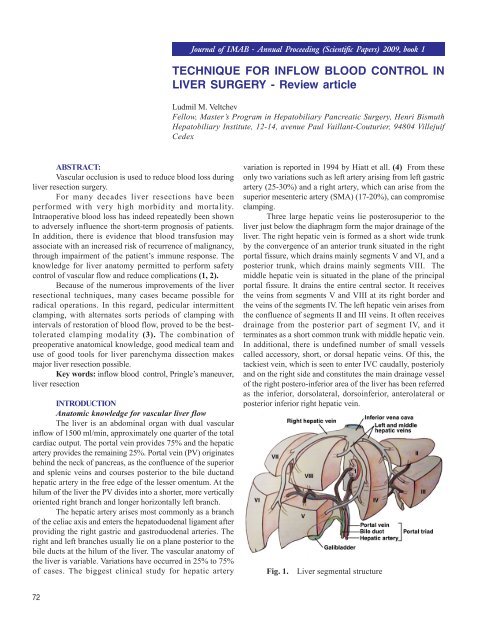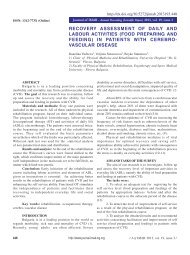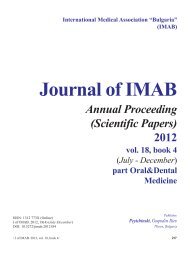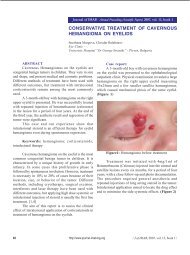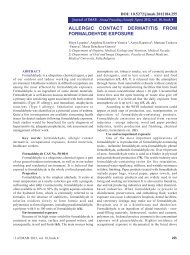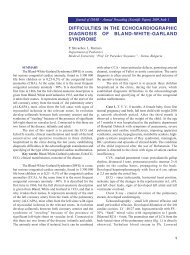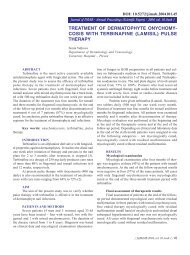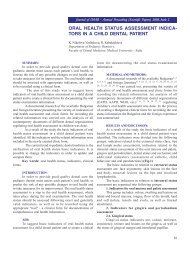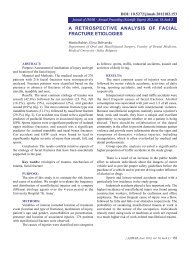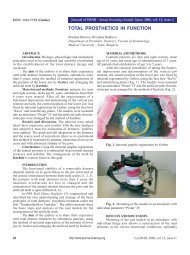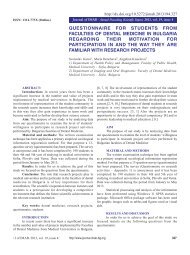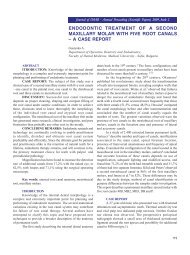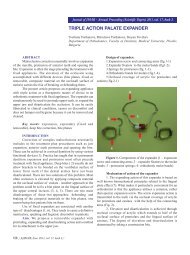Page: 72-74; FULL TEXT - Journal of IMAB
Page: 72-74; FULL TEXT - Journal of IMAB
Page: 72-74; FULL TEXT - Journal of IMAB
You also want an ePaper? Increase the reach of your titles
YUMPU automatically turns print PDFs into web optimized ePapers that Google loves.
<strong>Journal</strong> <strong>of</strong> <strong>IMAB</strong> - Annual Proceeding (Scientific Papers) 2009, book 1<br />
TECHNIQUE FOR INFLOW BLOOD CONTROL IN<br />
LIVER SURGERY - Review article<br />
Ludmil M. Veltchev<br />
Fellow, Master’s Program in Hepatobiliary Pancreatic Surgery, Henri Bismuth<br />
Hepatobiliary Institute, 12-14, avenue Paul Vaillant-Couturier, 94804 Villejuif<br />
Cedex<br />
ABSTRACT:<br />
Vascular occlusion is used to reduce blood loss during<br />
liver resection surgery.<br />
For many decades liver resections have been<br />
performed with very high morbidity and mortality.<br />
Intraoperative blood loss has indeed repeatedly been shown<br />
to adversely influence the short-term prognosis <strong>of</strong> patients.<br />
In addition, there is evidence that blood transfusion may<br />
associate with an increased risk <strong>of</strong> recurrence <strong>of</strong> malignancy,<br />
through impairment <strong>of</strong> the patient’s immune response. The<br />
knowledge for liver anatomy permitted to perform safety<br />
control <strong>of</strong> vascular flow and reduce complications (1, 2).<br />
Because <strong>of</strong> the numerous improvements <strong>of</strong> the liver<br />
resectional techniques, many cases became possible for<br />
radical operations. In this regard, pedicular intermittent<br />
clamping, with alternates sorts periods <strong>of</strong> clamping with<br />
intervals <strong>of</strong> restoration <strong>of</strong> blood flow, proved to be the besttolerated<br />
clamping modality (3). The combination <strong>of</strong><br />
preoperative anatomical knowledge, good medical team and<br />
use <strong>of</strong> good tools for liver parenchyma dissection makes<br />
major liver resection possible.<br />
Key words: inflow blood control, Pringle’s maneuver,<br />
liver resection<br />
INTRODUCTION<br />
Anatomic knowledge for vascular liver flow<br />
The liver is an abdominal organ with dual vascular<br />
inflow <strong>of</strong> 1500 ml/min, approximately one quarter <strong>of</strong> the total<br />
cardiac output. The portal vein provides 75% and the hepatic<br />
artery provides the remaining 25%. Portal vein (PV) originates<br />
behind the neck <strong>of</strong> pancreas, as the confluence <strong>of</strong> the superior<br />
and splenic veins and courses posterior to the bile ductand<br />
hepatic artery in the free edge <strong>of</strong> the lesser omentum. At the<br />
hilum <strong>of</strong> the liver the PV divides into a shorter, more vertically<br />
oriented right branch and longer horizontally left branch.<br />
The hepatic artery arises most commonly as a branch<br />
<strong>of</strong> the celiac axis and enters the hepatoduodenal ligament after<br />
providing the right gastric and gastroduodenal arteries. The<br />
right and left branches usually lie on a plane posterior to the<br />
bile ducts at the hilum <strong>of</strong> the liver. The vascular anatomy <strong>of</strong><br />
the liver is variable. Variations have occurred in 25% to 75%<br />
<strong>of</strong> cases. The biggest clinical study for hepatic artery<br />
variation is reported in 1994 by Hiatt et all. (4) From these<br />
only two variations such as left artery arising from left gastric<br />
artery (25-30%) and a right artery, which can arise from the<br />
superior mesenteric artery (SMA) (17-20%), can compromise<br />
clamping.<br />
Three large hepatic veins lie posterosuperior to the<br />
liver just below the diaphragm form the major drainage <strong>of</strong> the<br />
liver. The right hepatic vein is formed as a short wide trunk<br />
by the convergence <strong>of</strong> an anterior trunk situated in the right<br />
portal fissure, which drains mainly segments V and VI, and a<br />
posterior trunk, which drains mainly segments VIII. The<br />
middle hepatic vein is situated in the plane <strong>of</strong> the principal<br />
portal fissure. It drains the entire central sector. It receives<br />
the veins from segments V and VIII at its right border and<br />
the veins <strong>of</strong> the segments IV. The left hepatic vein arises from<br />
the confluence <strong>of</strong> segments II and III veins. It <strong>of</strong>ten receives<br />
drainage from the posterior part <strong>of</strong> segment IV, and it<br />
terminates as a short common trunk with middle hepatic vein.<br />
In additional, there is undefined number <strong>of</strong> small vessels<br />
called accessory, short, or dorsal hepatic veins. Of this, the<br />
tackiest vein, which is seen to enter IVC caudally, posterioly<br />
and on the right side and constitutes the main drainage vessel<br />
<strong>of</strong> the right postero-inferior area <strong>of</strong> the liver has been referred<br />
as the inferior, dorsolateral, dorsoinferior, anterolateral or<br />
posterior inferior right hepatic vein.<br />
Fig. 1.<br />
Liver segmental structure<br />
<strong>72</strong>
Hemodynamic response to Pedicle clamping leads<br />
to a moderate decrease in cardiac preload with a 5% decrease<br />
in pulmonary artery pressure and a 10% decrease in cardiac<br />
index is paradoxically associated with a 10% increase in<br />
mean arterial pressure (5). Isolated pedicle clamping usually<br />
is well tolerated and does not require specific anesthetic<br />
management. The blood pressure is restored to normal or<br />
shows an increase from the baseline during the period <strong>of</strong><br />
declamping. It is a frequently observed phenomenon,<br />
however, that as the cycle <strong>of</strong> clamping and declamping<br />
progress, declamping causes more significant hypotension.<br />
This can be observed when the cumulative period <strong>of</strong><br />
clamping exceeds 1 hour. Could be attributed to the<br />
reperfusion syndrome, owing to the long-term ischemia <strong>of</strong><br />
liver parenchyma and splanchnic release toxic vasodilators.<br />
It is recommended to increase the duration <strong>of</strong> declamping<br />
during each cycle, if the cumulative duration is prolonged<br />
more than 1 hour, especially in patients with diseased liver.<br />
Technique <strong>of</strong> vascular clamping<br />
Inflow control is the easiest method to reduce<br />
bleeding during liver resection <strong>of</strong> liver traumatic damage.<br />
Pedicle clamping, which controls the inflow has few<br />
hemodinamics consequences. Continuous clamping, which<br />
increases ischemic injury <strong>of</strong> the liver parenchyma, also<br />
induces splanchnic congestion. Intermittent clamping has<br />
supplanted the use <strong>of</strong> selective pedicle clamping to<br />
overcome these two drawbacks.<br />
surgical tourniquet, which should be closed until the pulse<br />
<strong>of</strong> hepatic artery distal to the clamp is stopped. When the<br />
left accessory artery exists, simultaneous occlusion <strong>of</strong> this<br />
artery should be performed.<br />
Continuous clamping: implies interruption <strong>of</strong> inflow<br />
continuously during the hepatic transaction phase, without<br />
intermittent release to allow reperfusion. The efficacy is<br />
limited because <strong>of</strong> splanchnic congestion and prolonged<br />
parenchymal ischemia.<br />
Intermittent clamping presents intermittent inflow<br />
occlusion with intervals <strong>of</strong> reperfusion. It reduces the<br />
consequences <strong>of</strong> splanchnic congestion and decreases the<br />
ischemic injury. After a short period <strong>of</strong> pedicle clamping (10-<br />
20 min) the inflow is restored for 5-10 minutes according to<br />
the duration <strong>of</strong> the transaction <strong>of</strong> liver. Classically each cycle<br />
comprises 15 minutes <strong>of</strong> clamping followed by 5 minutes <strong>of</strong><br />
reperfusion (5).<br />
Preconditioning: Clavien et al. (6) revealed that an<br />
initial period <strong>of</strong> ischemia (10 minutes) followed by<br />
reperfusion (10 minutes) protects the liver against prolonged<br />
ischemia and postulated that the benefits from the first<br />
clamp-unclamp sequence as a preconditioning treatment.<br />
CONCLUSIONS<br />
Performance <strong>of</strong> Pringle maneuver during liver<br />
transection results in less blood loss and better preservation<br />
<strong>of</strong> liver function in the early postoperative period. This is<br />
happening, because there was less hemodynamic<br />
disturbance induced by the bleeding. Intermittent vascular<br />
occlusion seems safe in liver resection. However, it does not<br />
seem to decrease morbidity. Among the different methods<br />
<strong>of</strong> vascular occlusion, intermittent portal triad clamping has<br />
most evidence to support the clinical application. Hepatic<br />
vascular exclusion cannot be recommended routinely.<br />
Ischemic preconditioning before continuous portal triad<br />
clamping may be <strong>of</strong> clinical benefit in reducing intensive<br />
therapy unit and hospital stay.<br />
Inflow vascular clamping - Pringle’s maneuver<br />
(hepatic pedicle clamping, which interrupts the arterial and<br />
portal venous inflow to the liver, is a standard in hepatic<br />
surgery. Clamping is achieved by a vascular clamp or<br />
73
REFERENCES:<br />
1. Makauchi M, Mori T, Gunven P, et<br />
al. Safety <strong>of</strong> hemihepatic vascular occlusion<br />
during resection <strong>of</strong> the liver. Surg Gynecol<br />
Obstet 1989; 130:824–831.<br />
2. Wobbes T, Bemelmans BLH,<br />
Kuypers JHC, et al. Risk <strong>of</strong> postoperative<br />
septic complications after abdominal<br />
surgery treatment in relation to<br />
preoperative blood transfusion. Surg<br />
Gynecol Obstet 1990; 171:<br />
3. Belghiti J, Noun R, Malafosse R, et<br />
al. Continuous versus intermittent portal<br />
triad clamping for liver resection. A<br />
controlled study. Ann Surg 1999; 229:369<br />
–375.<br />
4. J.R. Hiatt J.Gabbay,R W. Busuttil.<br />
Surgical Anatomy <strong>of</strong> the Hepatic Arteries<br />
in 1000 Cases. Ann Surg.1994 Vol. 220,<br />
No. 1, 50-52<br />
5. Belghiti J, Noun R, Zante E, Ballet<br />
T, Sauvanet A. Portal triad clamping or<br />
hepatic vascular exclusion for major liver<br />
resection. A controlled study. Ann Surg.<br />
1996 Aug; 224(2):155-61<br />
6. PE Clavien, S Yadav, d. Syndram, R.<br />
Bently. Protective Effects <strong>of</strong> Ischemic<br />
Preconditioning for Liver Resection<br />
Performed Under Inflow Occlusion in<br />
Humans. Ann Surg Vol. 232, No. 2, 155–<br />
162<br />
Corresponding author:<br />
Ludmil Marinov Veltchev, MD PhD<br />
Mobile: +359 876 259 685<br />
E-mail: drlmarinov@yahoo.com<br />
<strong>Journal</strong> <strong>of</strong> <strong>IMAB</strong> - Annual Proceeding (Scientific Papers) 2009, book 1<br />
OBESITY SURGERY: INDICATIONS,<br />
TECHNIQUES, WEIGHTLOSS AND POSSIBLE<br />
COMPLICATIONS - Review article<br />
Ludmil M. Veltchev<br />
Fellow, Master’s Program in Hepatobiliary Pancreatic Surgery, Henri Bismuth<br />
Hepatobiliary Institute, 12-14, avenue Paul Vaillant-Couturier, 94804 Villejuif<br />
Cedex<br />
SUMMARY<br />
In long-term perspective, the conservative treatment<br />
<strong>of</strong> obesity is always doomed to failure and only the surgical<br />
method allows reducing obesity. At this stage, the surgery<br />
<strong>of</strong> choice remains the gastric bypass, which is reduces on<br />
average 60-70% <strong>of</strong> the overweight and which is effective in<br />
80% <strong>of</strong> the operated patients. Preoperative preparation,<br />
surgical interventions and postoperative monitoring <strong>of</strong> the<br />
patients are crucial to its effectiveness.<br />
Key words: obesity, surgical techniques,<br />
complications<br />
INTRODUCTION<br />
The significant percentage increase <strong>of</strong> the population<br />
with overweight and the ineffectiveness <strong>of</strong> the medication<br />
treatment (diet, drugs) allow bariatric surgery to take an<br />
important place in the treatment (1, 2). At this point this<br />
type <strong>of</strong> treatment is the only one leading to a lasting effect.<br />
Basically, two mechanisms allow the unification <strong>of</strong> all<br />
known methods into three categories:<br />
- restrictive operations (gastric band and vertical<br />
gastroplastica)<br />
- low absorbing operations (jejuno-ileal bypass,<br />
biliopancreatic derivation)<br />
- mixed operations (gastric bypass)<br />
Description <strong>of</strong> techniques:<br />
a) Roux-en-Y Gastric Bypass (RYGB) works by<br />
restricting food intake and by decreasing the absorption <strong>of</strong><br />
food. Food intake is limited by a small pouch that is similar<br />
in size to the adjustable gastric band (3, 4). In addition,<br />
absorption <strong>of</strong> food in the digestive tract is reduced by<br />
excluding most <strong>of</strong> the stomach, duodenum, and upper<br />
intestine from contact with food by routing food directly<br />
from the pouch into the small intestine. (fig. 1.)<br />
b) Vertical Sleeve Gastrectomy (VSG) historically had<br />
<strong>74</strong>


